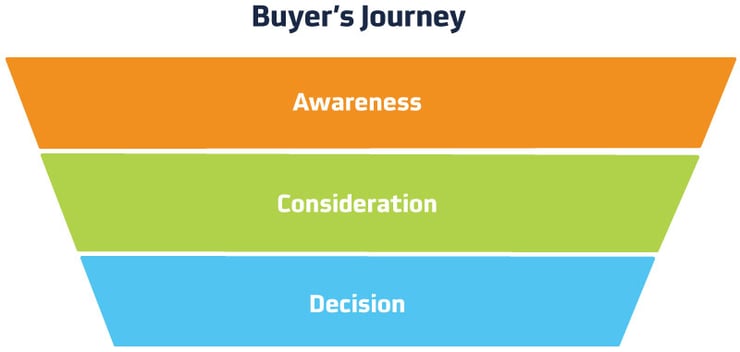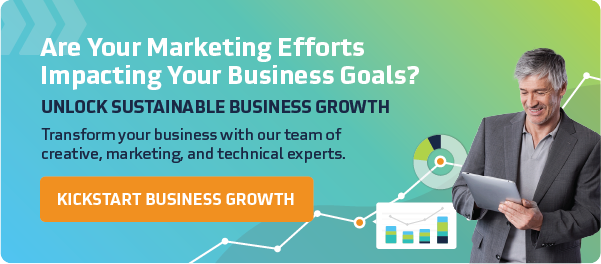Is An Inbound Marketing Strategy Right For Your B2B Company?
 Krista
|
Krista
|

Not seeing a return on your marketing investment? It might be time to try inbound marketing.
Do you ever feel like you’re throwing money at your marketing budget without seeing a return on investment? With so many digital marketing options, it’s easy to invest time and money in advertising, content creation, and social media without seeing sales growth. A solid inbound marketing strategy helps to focus your digital marketing message and efforts for the purpose of cultivating relationships, a necessity for business growth.
Before we explore whether an inbound marketing strategy is the right choice for your B2B company, let’s start with the basics.
What is Inbound Marketing?
Most traditional sales and marketing strategies are outbound marketing which is when companies reach out to consumers hoping some will be interested in their product or service. Cold calling and advertising are two examples of outbound marketing.
In contrast, inbound marketing is a holistic marketing approach, aiming to cultivate relationships with consumers who are likely to become your customers. An inbound strategy attracts, engages, and delights potential customers.
- Attract: Brands can attract their future customers by producing helpful content that addresses their ideal customer’s interests or needs.
- Engage: When customers are interested in what you have to offer because it provides an answer or solution to this problem, they’ll naturally want to engage with your brand. These engagements could be following on social media, reaching out with questions, joining a subscriber list, or otherwise connecting with the brand.
- Delight: An inbound marketing strategy aims to keep prospects engaged and delighted. After they become paying customers, its goal is to retain them and build loyalty.
Chances are you may already be practicing aspects of inbound marketing in your offline and face-to-face business relationships. In some ways, inbound strategy translates relationship building to an online environment. However, inbound marketing doesn’t stop with online marketing. It is a holistic approach that works best when integrated among marketing, sales, and customer service functions. Whether you offer a B2B product or service, the right inbound strategy nurtures your customers throughout their relationship with your brand.
To better understand inbound marketing, here’s an example. A small company offering a business-to-business service may publish a blog containing relevant industry news. This alone isn’t a strong inbound strategy unless there is a way to capture and qualify the leads. The brand’s marketing manager may create an in-depth whitepaper outlining solutions that their clients seek. In order to receive the whitepaper, the reader subscribes to the brand’s newsletter, which is an ongoing touchpoint that offers more helpful information and keeps the brand top of mind.
An effective inbound marketing strategy cultivates and guides these leads through the process of becoming loyal customers, transforming them from strangers to prospects to customers to brand promoters. Many in the field refer to this as the buyer’s journey.

Differences Between Outbound & Inbound Marketing
The primary difference between inbound and outbound marketing is that inbound marketing focuses on cultivating relationships with people with a need or interest in the solutions offered by your product or service. Outbound techniques like television and TV advertising reach a broad range of people, hoping that some will be interested.
HubSpot is a leading SaaS platform supporting inbound marketing strategies. They also walk the walk by building their clientele through resources that are helpful to marketers, salespeople, and small business owners. According to HubSpot, inbound marketing offers the advantage of attracting customers through tailored experiences.
Outbound marketing often interrupts the consumer while they are engaged in other activities. For example, a potential customer might be watching YouTube videos to better understand how to use a product when an unrelated ad pops up, interrupting their experience and providing no value. On the other hand, inbound marketing involves creating experiences or resources your ideal customer seeks. For instance, a B2B commercial HVAC company may offer helpful, top-of-the-funnel content to attract potential customers who will soon need their services. Audience members are receptive to the message because it is relevant to their needs or desires.
The inbound approach takes it a step farther. In addition to creating tailored experiences, the brand offers the customer an opportunity to build a relationship. An opt-in offer is one of the most powerful techniques. Not all opt-in offers are effective, though. Here are some qualities that make a compelling offer.
![]()
- Value. Offers should be valuable to your ideal customer, not the general public (if the appeal is too broad, it will be less effective).
- Alignment. Content that is closely aligned with your services or expertise will help potential customers understand how your product or service can solve their problem.
- No purchase necessary. An opt-in offer is useful even if the prospect doesn’t immediately make a purchase. Depending on where they are in the buyer’s journey, they may not be ready to buy yet, but having your offer in their back pocket can impact their decision-making process.
- Offer promotion. Promote your offer using content marketing and social media to attract a target audience. Those with the strongest interest will opt-in, giving your sales team warm prospects who are aware of your brand and have a need for your product or service.
Types of B2B Companies that Benefit from Inbound Marketing
Many successful business-to-business companies use a mix of outbound and inbound marketing tactics. Each has its own strengths and benefits. Inbound marketing has the added advantage of cultivating customer loyalty, which results in word-of-mouth referrals over time. Some smaller niche brands may even be able to build a clientele completely through inbound strategies and word-of-mouth.
As you may imagine, an effective digital inbound marketing strategy requires the right tools, expertise, and strategic thinking. Nearly any B2B business can benefit from effective inbound marketing, but most small to mid-sized companies don’t have the in-house talent to create and implement an effective inbound strategy. But don’t let that discourage you. A great way to get a feel for inbound marketing is by creating a campaign. We’ve pulled together a checklist that includes all of the key pieces needed for an effective inbound marketing campaign and provides step-by-step directions on how to create them.
If doing inbound marketing on your own isn’t an option, but you see the value, we’d love to talk to you. Being a HubSpot Solutions Partner and inbound experts, we know how to create effective inbound strategies that lead to long-term and sustainable growth. Schedule a free consultation to understand better inbound marketing and how it can help your B2B company, or visit our Services page to learn about our inbound marketing growth program.
More reading:
Subscribe to Our Blog
Stay up to date with the latest marketing, sales, and service tips.



